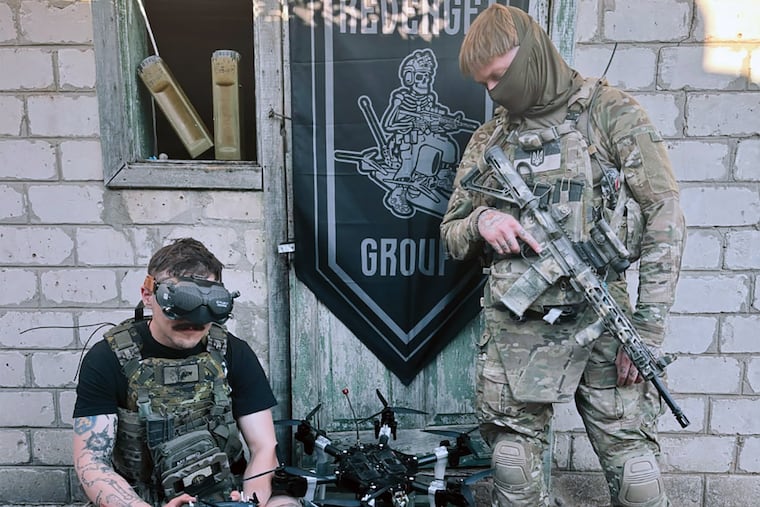» READ MORE: DRONE GLOSSARY
KHARKIV REGION, Ukraine — Last month, for the first time in this or any other war, Ukrainians captured Russian troops in this region using only robots and killer drones.
The tale sounds like something out of science fiction, yet it was simply an early episode in the evolving era of unmanned warfare.
Drone pilots from the legendary 3rd Separate Assault Brigade dropped a first-person view attack drone into a Russian trench, and a ground robot launched a rocket. The robot also broadcast a message: Surrender or die. Seventeen Russians emerged, hands up, and an aerial drone guided them toward waiting Ukrainian soldiers who took them prisoner.
The capture only burnished the group’s reputation, already lauded for its tough fighters and its popular recruitment campaign.
But the brigade’s special battalion for intercepting enemy drones, known as “SQUADRON,” has also become famous for its prowess.
In June, I met SQUADRON’s commander, call sign Betsyk (an abbreviation of his hometown), and his chief of staff Zakon (meaning law), 26, in a basement headquarters in the region. They became friends and joined up together in the first weeks of the invasion.
Not far away is the city of Izyum, briefly occupied by the Russians, and the war crimes committed there are always on these men’s minds.
Betsyk, who was already in university and working for a tech company, was only 18, but he downed a helicopter before reaching 19. Zakon was an oil and gas lawyer and said he’s now “married to drones.”
“Every battalion or even company in the 3rd has a drone lab that also works on ground robots,” Zakon told me. Most labs are small, he explained, but this one expanded to “120 smart guys,” so it could make a bigger impact on the innovation process and share their expertise with other brigades.
“The goal is to instill AI and best business processes into the army,” Zakon said. He tells potential recruits that “you can do what you did privately in tech firms or as gamers, but join the army. We have hundreds of new recruits.”
For this elite unit, that is no doubt true, but drone innovators as well as pilots are an endangered species, with each side eager to kill the other’s experts. That makes the work of this unit more vital and more fraught.
In daily contact with drone pilots, they constantly update Ukrainian forces and private manufacturers about shifts in Russian technology. As Betsyk tells me, “The Russians learn fast. They are starting to use artificial intelligence to maneuver [drones], but our guys solve all Russian maneuvers.”
This is how Ukraine maintains its technological edge.
The battalion also maintains contact with NATO allies and private European drone makers that send representatives to test its products at the front. This helps Europeans keep up with critical technological changes in drone warfare — and with Russian techniques. “Lots of small European countries call us,” says Betsyk.
And they are working with one U.S. company (which they won’t name) on new methods to destroy the Shahed drones that are causing havoc in Ukrainian cities.
In the battalion’s manufacturing center — a maze of rooms lined with towers of drones for engineering, programming, and testing — the techie soldiers explore new features on a drone simulator. The atmosphere and dress code are casual, the focus intense.
The name of our unit is “Revenge,” I’m told by a 26-year-old who goes by the call sign Steppe (meaning fields) and who is working on a simulator. “Revenge is what keeps us motivated, because of all our comrades killed and wounded. We solve technical problems for the front line [positions]. We need to modify drones and adapt to different frequencies” when the Russians change theirs, he said.
His colleague, call sign Obriy (meaning horizon), chimed in: “When the Russians beat our solution, you need to find new solutions. We have a specific group doing only R&D, so we can react quickly to new threats. They go to the [front line] positions and test, sometimes upgrade, sometimes something new.”
The battalion is constantly looking for new ways to kill Russian drones. “We can connect manufacturers directly with [military] units, which makes their products more effective,” Obriy added.
On this visit, I heard the same from every forward drone unit I visited about U.S. drones brought for testing by the U.S. military earlier in the war: They didn’t work well. They were either unable to overcome Russian jamming or flew shorter distances than expected.
Would that more American drone producers, along with the Pentagon, were still making use of the opportunity to test or coproduce drones with Ukraine.
But I also wish that President Donald Trump could hear why these young volunteers will not stop fighting if he tries to hand Ukraine over to Vladimir Putin.
“I saw pictures of ‘44 Dresden,” Obriy said heatedly. “Well, here, Russia levels nine story apartment buildings, so many lives are taken. When other countries say, ‘you should have peace…’ How? When whole families are slaughtered? When people who speak Russian, in Crimea and Mariupol, fought with their bare hands against Russian killers.”
Call sign Dev, who had just returned from the front line, jumped in.
“There was so much terror in Izyum. There were 500,000 people living here and now there are 100,000. We have been repressed by Russia for 100 years. We have no option but to fight because Russia came to kill our independence.”
Steppe added: “We will continue to fight for our independence and to prevent the enemy from coming again.”
This is the message I got repeatedly from frontline drone units.
Before I left, Zakon repeated: “The United States has an excellent opportunity to test here. You need to test weapons.”
He’s correct. Instead of undermining Kyiv, the United States badly needs to learn from Ukraine how to counter Russia’s advanced drone skills before they are used against the rest of Europe — or us.
